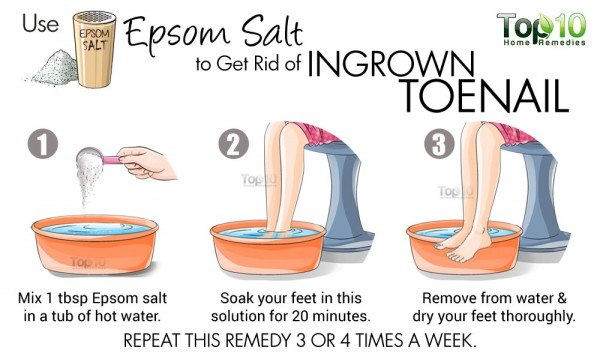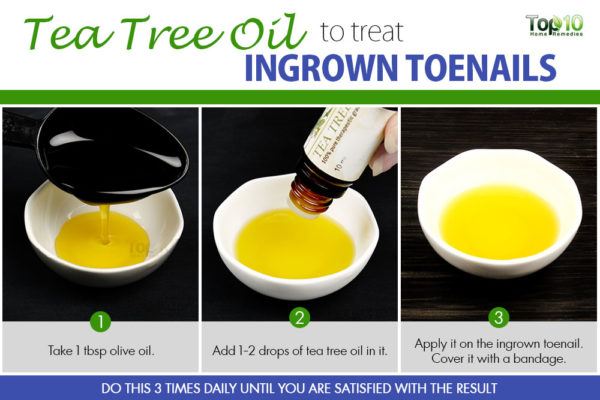Note: Do not self-treat this condition at home if you suffer
from conditions like diabetes, poor blood circulation to your foot, or
nerve damage in your leg or foot.
An ingrown toenail, also known as onychocryptosis, is a common problem. When the corner or side edge of a toenail grows into the soft flesh of the nearby skin, it causes a lot of discomfort. It is most common in toenails but, in rare instances, fingernails can also become ingrown.

Causes of ingrown toenails include wearing tight-fitting shoes, improper trimming of nails, a nail injury and having unusually curved toenails.
People suffering from diabetes or other health problems that cause poor blood circulation to the feet are at a higher risk of developing this painful nail problem.
Some symptoms include persistent pain, redness and swelling. If left untreated, onychocryptosis can soon lead to infection.
Signs of infection include redness and swelling around the nail, drainage of pus and watery discharge tinged with blood.
It is easy to take care of an ingrown nail at home, if caught early. However, if you notice signs of infection, get it checked by a doctor, or else it may may spread and cause complications.

Here are the top 10 ways to get rid of ingrown toenails.

It helps soften the skin around the affected area, which makes it easy to draw out the ingrown nail. It also helps bring down the inflammation.
Follow either of these remedies 2 or 3 times daily until you are satisfied with the result.

The compound curcumin in turmeric has antiseptic, anti-inflammatory and pain-relieving ability.

The antiseptic nature of tea tree oil can help relieve pain and reduce the risk of infection due to an ingrown toenail.
Note: If irritation occurs after applying any essential oil, stop using it.

It even reduces the risk of an infection and also promotes healing.

Always trim your nails straight across and avoid giving them a curved shape to match the shape of your toe. When trimming, always start with the edges, not the middle part.
It is also important to file the nails to get rid of any sharp edges. Always use a good quality nail clipper and file.
Keep your toenails at a moderate length. If cut too short, they may dig into the skin as they grow, ultimately causing an ingrown nail.
Note: If you cannot trim your nails properly due to a medical condition, get them trimmed by a professional.

To prevent ingrown toenails, consider wearing sensible footwear. In fact, one of the main reasons behind this painful nail problem is wearing poorly fitting and tight footwear.
Shoes that place too much pressure on your toes can cause a nail to grow into the surrounding tissue. Shoes made of soft fabrics with a roomier toe are an ideal solution. Women should avoid high heels to relieve the pressure on the toes.
Additional Tips
Source Click here
An ingrown toenail, also known as onychocryptosis, is a common problem. When the corner or side edge of a toenail grows into the soft flesh of the nearby skin, it causes a lot of discomfort. It is most common in toenails but, in rare instances, fingernails can also become ingrown.

Causes of ingrown toenails include wearing tight-fitting shoes, improper trimming of nails, a nail injury and having unusually curved toenails.
People suffering from diabetes or other health problems that cause poor blood circulation to the feet are at a higher risk of developing this painful nail problem.
Some symptoms include persistent pain, redness and swelling. If left untreated, onychocryptosis can soon lead to infection.
Signs of infection include redness and swelling around the nail, drainage of pus and watery discharge tinged with blood.
It is easy to take care of an ingrown nail at home, if caught early. However, if you notice signs of infection, get it checked by a doctor, or else it may may spread and cause complications.

Here are the top 10 ways to get rid of ingrown toenails.
Contents
1. Warm Water Soak
When suffering from ingrown toenails, warm water foot soaks a few times a day can help a great deal in relieving the swelling, pain and tenderness caused by this problem.- Fill a small foot tub with warm water.
- Soak your feet in it for 15 to 20 minutes.
- Do this 3 to 4 times a day to get relief.
2. Cotton Wedge under the Nail
After a warm water soak, you can place a cotton wedge under your affected toenail to help it grow above the skin. This will even relieve pain and speed up the healing process.- Soak your feet in warm water, then dry them thoroughly.
- Carefully lift the affected nail with a blunt pair of tweezers.
- Place a small rolled piece of cotton between your nail and the skin.
- Replace the cotton every time you soak your feet to prevent infection.
3. Epsom Salt
Epsom salt, scientifically known as magnesium sulphate, is effective for treating ingrown toenails.
It helps soften the skin around the affected area, which makes it easy to draw out the ingrown nail. It also helps bring down the inflammation.
- Mix 1 tablespoon of Epsom salt in a foot tub filled with warm water.
- Soak your feet in this solution for 20 minutes.
- Remove from water and dry your feet thoroughly.
- Repeat this remedy 3 or 4 times a week.
4. Apple Cider Vinegar
Apple cider vinegar is also helpful for ingrown toenails. Its antiseptic and anti-inflammatory nature can help relieve the symptoms. Plus, its mild acidic nature prevents infection.Follow either of these remedies 2 or 3 times daily until you are satisfied with the result.
- Mix equal amounts of raw, unfiltered apple cider vinegar and warm water in a small foot tub. Soak the affected toenail in this solution for 20 to 30 minutes. When done, dry your toenail thoroughly.
- Another option is to soak a cotton ball in raw, unfiltered apple cider vinegar and place it on the affected area. Cover it with a bandage for a couple of hours, then remove it.
5. Hydrogen Peroxide
Hydrogen peroxide is an effective disinfectant that helps reduce the risk of infection and relieve pain and inflammation caused by an ingrown toenail.- Mix approximately ½ cup of hydrogen peroxide in a small tub of warm water.
- Soak the affected toenail in this solution for 20 minutes.
- Do this once or twice daily.
6. Turmeric
You can also use turmeric to get rid of ingrown toenail discomforts, such as pain, swelling and inflammation.
The compound curcumin in turmeric has antiseptic, anti-inflammatory and pain-relieving ability.
- Make a paste of ½ teaspoon of turmeric powder and a little mustard oil. Smear the paste all over the affected toe and cover it with a bandage. Repeat 2 or 3 times daily for several days.
- Alternatively, apply antibiotic cream containing curcumin on the tender area and bandage the toe. Reapply 2 or 3 times daily.
- Also, boil 1 teaspoon of turmeric in a glass of milk. Drink it twice daily to reduce pain and speed up the healing process.
7. Tea Tree Oil

The antiseptic nature of tea tree oil can help relieve pain and reduce the risk of infection due to an ingrown toenail.
- Put 1 or 2 drops of tea tree oil in 1 tablespoon of any carrier oil, such as olive or coconut oil.
- Apply it on the ingrown toenail and cover it with a bandage.
- Do this three times daily until you are satisfied with the result.
Note: If irritation occurs after applying any essential oil, stop using it.
8. Indian Lilac
Indian lilac, also known as neem, has inflammation-reducing and pain-suppressing properties that can alleviate pain, inflammation and swelling due to an ingrown toenail.
It even reduces the risk of an infection and also promotes healing.
- Boil a handful of neem leaves in 4 cups of water. Strain and allow it to cool down a bit. Soak the affected toe in this solution for 10 to 15 minutes. Make sure to dry the area thoroughly. Repeat twice daily.
- Also, before going to bed, apply neem oil on the affected area and leave it on overnight. Do this daily.
9. Trim Correctly
To prevent recurring ingrown toenails, it is important to trim your nails correctly.
Always trim your nails straight across and avoid giving them a curved shape to match the shape of your toe. When trimming, always start with the edges, not the middle part.
It is also important to file the nails to get rid of any sharp edges. Always use a good quality nail clipper and file.
Keep your toenails at a moderate length. If cut too short, they may dig into the skin as they grow, ultimately causing an ingrown nail.
Note: If you cannot trim your nails properly due to a medical condition, get them trimmed by a professional.
10. Sensible Footwear
When suffering from an ingrown toenail, wear open-toed shoes or sandals to provide the affected toe extra room and allow it to breathe to heal quickly.
To prevent ingrown toenails, consider wearing sensible footwear. In fact, one of the main reasons behind this painful nail problem is wearing poorly fitting and tight footwear.
Shoes that place too much pressure on your toes can cause a nail to grow into the surrounding tissue. Shoes made of soft fabrics with a roomier toe are an ideal solution. Women should avoid high heels to relieve the pressure on the toes.
Additional Tips
- Do not wear socks and shoes while at home. This will allow the affected toenail to get exposed to fresh air to promote fast healing.
- Give the affected toe some rest to aid healing.
- Except when soaking, keep your feet dry as much as possible.
- Take care of your feet properly and trim your nails straight across regularly to prevent such problems.
- Maintain proper foot hygiene by washing your feet regularly and drying them thoroughly.
- Always wear comfortable and properly fitting footwear.
- Scrub your feet with a pumice stone on a daily basis to prevent the formation of hard skin.
- Wear only cotton socks and change them daily.
- Inspect the affected toe carefully for signs of infection, such as redness, increased pain, swelling and drainage of pus.
- Diabetic people should check their feet daily for signs of toenail infections or other foot problems.
- If an ingrown toenail persists for a couple of weeks or shows signs of infection, consult a doctor to avoid any complications.
Source Click here
Comments
Post a Comment